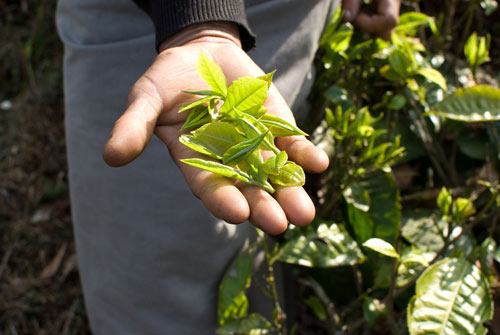
Darjeeling Tea
Darjeeling is located in the hills of West Bengal. It is the center of the tea industry that can trace its roots back to the British Raj.
The tea that is grown around Darjeeling is Camellia Sinensis. Yes, tea is part of the same family as the camellia flower, which is Camellia Japonica.
If left to grow untrimmed, the tea bush would grow to seven feet tall. However, it is pruned and trimmed to a low-growing bush for easy picking. Well that is the explanation that is given, but it beats me how a two foot (60cm) tall bush is the ideal pruning height.
Whatever the reason, the result is a carpet of bushes set a foot or so apart stretching up and down the hills in every direction.
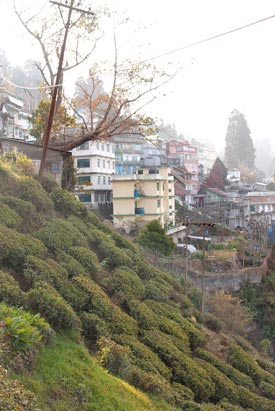
These tea bushes cover every inch of the landscape from the steep slopes around Darjeeling to the lowland plains around Siliguri – three hours drive along a battered road.
The reason why the only road in or out is in such poor condition is the subject of another story, about the political aspirations of the people of this region.
A Little History
Tea has been grown here since the British introduced it in the 1800s and some of the original bushes are still growing here and producing tea.
The British influence can still be seen in the way the tea estates are described. They can be several hundred acres in size but they still known by the quaint name of ‘tea gardens’.
The Rain Is Late This Year
In a normal year in the Darjeeling region the rains come in January and February and the early crop of leaves on the tea bushes are ready for picking at the beginning of March.
It didn’t rain in January or February last year or the year before, and it didn’t rain this year. As a result, the early crop has been lost. Last year production was down 20%. It cannot be made up at the other end of the growing season, so what is lost is lost.
The early crop is the best and the tea made from it is the most expensive, so the loss of the early flush of leaves is a double calamity for the tea growers.
At the Darjeeling Tea Planters Association Clubhouse we spoke to the managers of three tea estates and they all believe the delay in the rains is due to global warming.
In the second week of March the leaves were ready for picking lower down the slopes, well below Darjeeling. So that is where we had to go if we were to see tea being picked.
Getting There
Darjeeling is at 7,000 feet (2,100m) and it is a long walk even part way down the valleys and a longer walk back up.
It is just an early morning’s walk to school in Darjeeling though for the children who live in the small villages that dot the valleys.
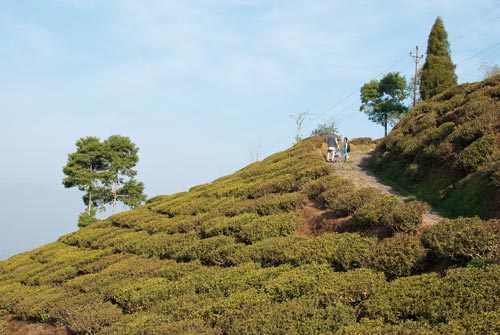
Arranging A Visit
We rang the manager of one of the tea estates and agreed to meet him the next day on the estate.
The town of Darjeeling is spread out on a mountainous ridge and having already been there a few days we knew that more or less everything one does involves either a steep walk uphill or downhill.
Tamara was recovering from a bout of food poisoning, so I went alone the next day to meet the manager of the plantation.
When I saw the tea processing factory far below the road surrounded by tea bushes, my heart sank knowing that if I walked down I would have to walk back up.
They Are Picking Far Below
Down at the factory, Mr. Gurung the manager asked me whether I was ready for the walk and said that the bushes that were being picked that day were far below.
I smiled and said I had already come far. Inside, however, I was balancing how much I wanted to see tea being picked and how much I wanted to turn around and go back. I was also wondering what he meant by ‘far’. Did he mean the distance was ‘far’ for him or ‘far’ for a tourist unused to walking up and down mountains?
Mr. Gurung detailed a very amiable young man, Bishal Rai, one of his factory workers, to show me the way and off we set walking down the steep paths.
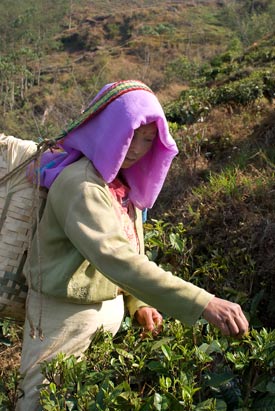
And on we walked for an hour or more until we reached a small shed, and then on further down still to where the women were picking the leaves.
On the way I learned that the wage for a tea picker in this part of the country is 62 rupees per day, that the bushes are pruned and trimmed in the off season by men, and that each bush produces about three ounces (90g) of finished tea per year.
Later on I inadvertently knocked over a basket when I stepped back to take a group photo, and learned from one of the women tea pickers that the first flush of leaves is “like gold”.
When I joined in to pick the leaves out of the grass and was told that I had picked up enough, I said “no, it’s like gold!” and that got a good laugh from the women. They were a lively bunch – very warm and friendly.
The 62 rupees that is the daily wage for a tea picker is about £0.90 pence or $1.40 at the current rate of exchange.
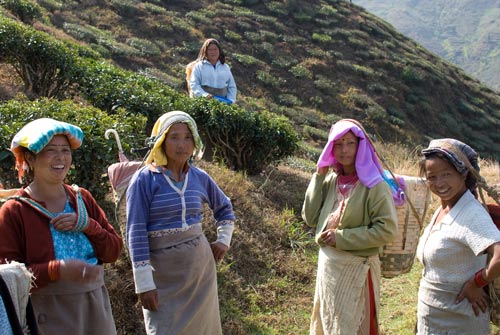
Postscript: The Himalayas
It rained on just one day while we were in Darjeeling. The morning after, we had a clear view from Darjeeling to the Himalayas and the famous peak of Katchenjunga some 45 miles (70km) away.
